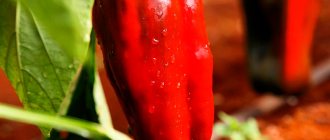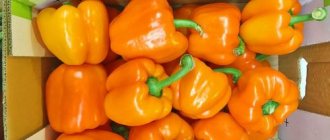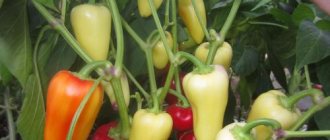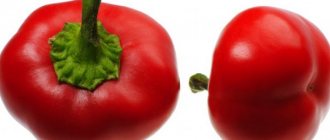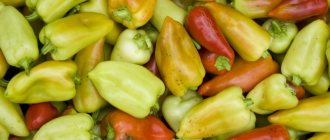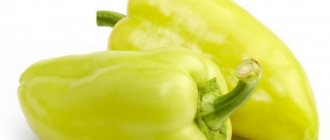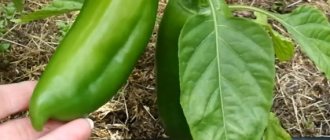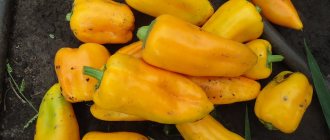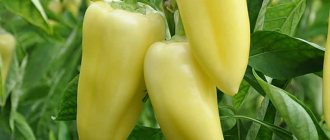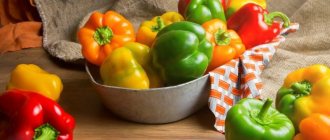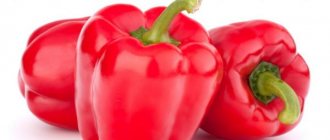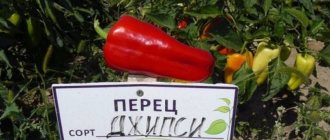Description of the variety
The Vladyka pepper is one of the newest varieties of vegetables. As of the summer of 2021, there is no information about it in the State Register of the Russian Federation. However, many gardeners from different regions cultivate vegetables in greenhouses, open ground and greenhouses.
The plant has all the characteristics of standard varieties. It is of medium height (about 75 cm), with a strong stem, large leaves, and blooms profusely. In one period, up to 10 fleshy vegetables can form on a bush.
The fruits are green at the stage of incomplete ripeness, and when they reach final ripening they become burgundy-red. The shape of the pepper is similar to an elongated cone with slight ribbing (see photo). The average weight of a vegetable is 250 g. However, some gardeners managed to grow fruit twice as large as this. Pepper has massive walls 8–10 mm thick. Its length is more than 18 cm.
| Type of growth, bush height | Standard, 70-85 cm |
| Ripe fruit color | Dark red |
| Planting scheme | 70x40 cm |
| Weight, length and shape of the fruit | 200-300 g, 18-20 cm, cone-shaped |
| Ripening period, yield | Early ripening (from sowing 70-75 days). 10 – 12 kg/m2 |
| Drop off point | exhaust gas/greenhouse/greenhouse |
| Diseases | Resistance to tobacco mosaic virus, potato virus |
| By type of use | Universal |
| Flowering type | Mixed |
Landing
Sowing dates begin in mid-February and last until the end of March. Seeds are pre-prepared:
- select whole, plump ones;
- immerse in 1% saline solution and discard any that float;
- activated in aloe juice or ash infusion, stimulant solution (Immunocytophyte, Epin);
- soak in a moistened cloth until biting.
The depth of the soil is up to 2 cm. The nutrient mixture chosen is sod-compost-humus.
After the first leaves appear, the seedlings are planted in separate pots (dimensions 10 by 10 cm). Keep the seedlings warm (18-25 degrees). Phytolights are turned on to extend daylight hours to 12-14 hours. Before transplanting, young bushes are hardened off for 10 days.
Advantages and disadvantages
Pepper Vladyka attracts gardeners with the following characteristics:
- The culture is resistant to several types of dangerous viruses.
- The fruits are aromatic and have a distinct taste, regardless of cooking.
- The plant is distinguished by massive ovaries, which has a positive effect on yield indicators.
- Pepper can be transported without fear of deformation.
- The vegetables are large and attractive in color.
- The culture develops well in open and closed beds, as it can withstand short-term cold snaps and droughts.
- Seeds extracted from the fruit can be saved for later planting.
The main disadvantage of the variety is the need for shaping. Without proper pinching, peppers grow small.
Pepper “Zhupsky Early”: photo and description of the variety
In its homeland, the Župska Rana is one of the most delicious sweet peppers. Suitable for growing in a greenhouse to obtain an early harvest, it can also be successfully grown in open ground. The bush is strong, compact and abundantly fruiting; the plant height reaches an average of 60 cm.
The fruits are long (up to 15 cm long), flat, slightly curved, the weight of one is 100-200 g. At technological maturity, the color of the fruits is yellow-green, and at biological maturity the peppers become intensely red. The pulp is thick, fleshy, and has a sweetish taste.
The variety is unpretentious and resistant to most diseases. In terms of ripening time, as the name suggests, “Zhupsky early” refers to early ripening varieties of pepper and produces a harvest approximately 90 days after germination. It is suitable for fresh consumption, stuffing and canning. The yield of the variety during industrial cultivation ranges from 25 to 35 tons per hectare. In the garden, the yield is 5-10 kilograms per square meter.
Sweet pepper “Župsky early” (Župska Rana).
My impressions of the variety
This variety, indeed, brought the harvest earlier than other varieties of sweet peppers last season. The fruits were quite large, but, unfortunately, they also did not have thick walls, and the wall thickness was only 5 mm or less. But the strong sweetness impressed me very much, and the Zupsky Early pepper became our favorite for fresh consumption. The bushes were not too tall, the yield was average. The elongated configuration and not too wide fruits also made it possible to actively use this variety for baking, stuffed with vegetables and cheese, along with other long-fruited varieties.
Features of agricultural technology
Seedlings should be chosen as the cultivation method. Vladyka pepper is grown taking into account the following recommendations:
- sowing of seeds is carried out 2.5 months before the seedlings are supposed to be moved to a permanent place;
- Picking of seedlings is carried out after the appearance of 2 leaves;
- peppers are placed in beds with loamy soil;
- bushes are fed 3 times: 2 days after planting, during flowering, during fruit ripening;
- When watering, avoid waterlogging.
Advice. The soil should be irrigated after sunset. To do this, the water must be kept in direct sunlight during the day.
Sowing seeds for seedlings | Planting seedlings in a greenhouse/greenhouse | Planting seedlings in exhaust gas | Stepsoning | Harvesting |
| End of February - March | Beginning of May | May June | Removing crown buds, eliminating all shoots up to the main fork | From August |
| *dates are indicated for central Russia | ||||
Growing conditions
To grow Vladika pepper you need:
Warm. The optimal air temperature for growing peppers is 25 °C. When the temperature drops below 15 °C, plants stop developing.
When growing seedlings, the temperature regime can be maintained. But after planting seedlings in open ground or a greenhouse, this becomes more difficult to do, but not with this variety.
The Vladyka pepper can be grown in different conditions. It is more resistant to weather surprises than other varieties. This was facilitated by the work of breeders to combine all the positive qualities of other varieties in one variety.
Ripening Vladyka pepper (photo)
Loose fertile soil. It should be rich in organic matter. This means that it is better to grow peppers where organic fertilizers are constantly applied.
If there are no such places, then it is better to start preparing the soil for planting in the fall. During the autumn digging you need to add cow or horse manure. For the winter, the soil must be mulched with sawdust or mowed grass. When growing Vladika pepper, this will be enough.
Expert opinion
Yulia Yurievna
I have a large garden and vegetable garden, several greenhouses. I love modern methods of cultivating plants and mulching the soil, and I share my experience.
Ask a Question
The season before planting the crop, green manure plants can be planted. They will naturally restore soil fertility. Immediately before planting, it is better to add well-rotted organic matter. Even if the soil is prepared in advance, it is better to use only fermented organic products, or, before planting, you will have to thoroughly disinfect the soil to protect it from pathogenic bacteria or spores. In addition, organic matter alone is not enough, because it contains mainly nitrogen, and for normal development, fruit set, and a good harvest, phosphorus and potassium are also required. Ash or minerals - superphosphates, potassium sulfate - will help with this. It is very important to make the soil for planting peppers loose and drained, because such a crop can die very quickly from stagnant moisture. If dark spots appear at the base of the bush and the stem softens, this indicates the development of blackleg - a fungal disease. Infected plants should be removed immediately; they cannot be cured, and the rest should be watered with a fungicidal preparation. We recommend carrying out the treatment several times, reviewing the mode and temperature of the water for irrigation. The optimal method of watering is drip irrigation. This way the rhizome will receive a sufficient amount of water, but there is no danger of overflow or stagnation of moisture in the soil.
A good place. Pepper plants require light. The place where the plantings are located should be illuminated by the sun all day. The best place to grow the Lord is the highest in the area where the soil warms up first. This elevation must be protected from drafts. A place under trees or on the north side of the house is not suitable.
Watering. Timely watering is one of the important growing conditions. The soil in the root layer of pepper should be constantly in a state of moderate moisture. Overwatering and underwatering have a bad effect on the condition of the plant.
Feeding. During the seedling period, fertilizing with mineral fertilizers such as Fertika or Aqua should be alternated with spraying with biostimulator HB-10 in the following mode:
Once a week - under the root of Fertik according to the instructions
Next week - spraying with HB-101 at the rate of one drop per liter of settled water at room temperature
After planting in open ground or a greenhouse, fertilizing with mullein infusion once a month is sufficient.
Plant formation. Despite the concerns of novice vegetable growers, this procedure is very simple.
When the first flower forms, it must be plucked off. After several fruits have formed on each branch, the top of this shoot needs to be pinched so that they become full.
Expert opinion
Yulia Yurievna
I have a large garden and vegetable garden, several greenhouses. I love modern methods of cultivating plants and mulching the soil, and I share my experience.
Ask a Question
Reviews
Mention of the variety is often found in reviews of farmers’ favorite vegetable crops. For example, gardener Elena wrote in her material that pepper is unusually sweet and juicy, its weight can reach 300 - 400 g.
Tatyana from Tula ranked this pepper among her favorites. She noted the good productivity of the plant. Lyubov from Novosibirsk said: in terms of the number of fruits on a bush, pepper is superior to many of the most popular hybrids. The variety is not capricious, immune to diseases.
Pepper Vladyka has won the recognition of a considerable number of farmers. It is planted in areas with different climatic conditions, since the vegetable is adapted to warm and unprotected beds.
Lord of Hearts – Sweet Pepper
In the vast majority of Russian climatic zones, it is more rational and economically profitable to grow sweet peppers with seedlings.
Sow seeds in boxes or cups in February-March, and in beds - no earlier than May-June.
You should definitely check the seeds for germination in January, so as not to be late with the seedlings if you have to replant.
The Vladyka pepper is considered universal in many respects, the main characteristics of which are:
- suitable for both open ground and greenhouses;
- to technical maturity - 60 days from the moment of picking seedlings;
- mature fruits grow up to 250 mm in length, elongated in shape;
- color of biological maturity – bright red;
- the pulp is about a centimeter thick, the taste is excellent;
- height of the bush in the garden bed – up to 80 cm;
- excellent resistance to most crop diseases.
Suitable for salads, stewing, canning, grilling and other cooking methods.
Mid-season pepper Goby reaches technical maturity in 4 months. The plant is about half a meter, not too spreading. After some time, the picked fruits will turn orange and sunny. The shape of the peppercorns is round, slightly elongated at the end. This is not the largest variety, weighing about 150 grams. The pulp is about 5 mm, crispy, sweet. Applications – varied, fresh and prepared.
Harvest in July - no problem
Not everyone is familiar with the description of the Vedran pepper, but it won its audience with its original peel color. It is light, almost white. Some hybrid varieties have a greenish-white color. Early ripening Vedrana pepper is distinguished by an abundant harvest of smoothed fruits, about 200 grams, thick-walled, about 10 cm in diameter. When cut, the pulp is 7-8 mm, tasty, juicy. Suitable for all cultivation methods. They get 6 kilograms from the garden.
You can pick Boneta peppers from their branches as early as July, as they will ripen in 85-90 days. The bushes of the variety are not tall, so they are suitable for a balcony, but they are powerful and branched, up to 55 cm. 4, maximum 5 sprouts are planted per square meter bed. The ripe fruit is a beautiful light green, later becoming orange-red. Shape - trapezoidal, weight 50-230 grams, pulp thickness 6-7 cm. Average yield - 3 - 3.5 kg. The taste is sweetish, without bitterness.
In lilac color
Rave reviews about the Purple Bell pepper most often include the following words: purple beauty, yield 7 kg, high sugar levels make the fruits very tasty, and the unusual color adds piquancy to salads. The variety requires 4 months to ripen. Spreading large bushes. The peppers are large, slightly ribbed, 90-100 mm in diameter. The thickness of the pulp is 7-8 mm. If you leave the fruit on the plant, it will ripen to a beautiful red color.
A delight not only for gourmets, but also for aesthetes, Bucharest pepper is bright purple in color. Thanks to its fantastic color, it has a wide range of uses in cooking. A large plant reaches a height of one meter in a greenhouse and a little less on the ground. Cone-shaped fruits with two or three chambers, up to a third of a kilogram. At the stage of biological maturity they acquire a purple color. The peculiarity of this variety is the ability to grow indoors. To do this, the plant is either immediately purposefully grown at home, or the life of the one transplanted from the garden is extended. In the house, peppers are more compact in size than in nature, only 50 cm. But fruiting and ripening occur without problems, especially if the place is well chosen, with sufficient lighting and warmth.
Pepper for real patriots
Another early-ripening variety with a patriotic name is suitable for any region. The most appreciative reviews of the Pride of Russia pepper are for its unpretentious nature and high resistance to disease. Characteristics: ripening period - about 100 days. Two dozen peppers are tied on a fairly small bush. It is interesting to watch their maturation: from green they turn into all shades of red, in the last phase - bright scarlet. The shape resembles a small icicle, weighing 100-150 grams, 5-7 mm at a cut. Lightweight, easily transportable variety.
Mid-early Butuz pepper bears fruit best in a closed place. The hybrid matures in 3 - 3.5 months. The plant is 75-80 cm high. The fruits are elongated, apple-green in color; when fully ripe, they turn red. The peel is glossy, as if waxy. Productivity – 6 kg. The purpose is universal.
Early ripening peppers
Early ripening, productive, disease resistant, juicy sweet crispy fruits - reviews of the Granova pepper and the Gigant variety are always positive. It takes only 100 days before harvesting, but it is abundant - in a favorable year it is even very large, 8-10 kilograms. The peppers are large, cube-shaped, more than 200 grams. Ripe ones are light, greenish, gradually turning into red. Bushes of medium height, 50-60 cm.
Boyarin pepper, specially selected for the climate of central Russia, gives owners a yield of up to 5 kg per meter. Compact bushes half a meter high tolerate low temperatures well and are resistant to fusarium and other viruses. The vegetable changes the color of its peel. First green, then red. The weight of one is 100-160 g. The thickness of the peel is average, 5-7 mm. The fruits are sweet, juicy, piquant. The shape is slightly elongated, flattened at the end. Application – universal.
Exotic chocolate
Ultra-early ripening (less than 90 days) Hannibal pepper is named after the Pushkin hero, the Arab Peter the Great. Its original color when ripe is chocolate. Abundant harvest of 8 to 9 kg. Fruits with a bright aroma, about 150 g, in the shape of a prism. The plant is compact. A favorite among many gardeners for its excellent taste, rapid ripening, abundance of fruits and fairly unpretentious cultivation.
From hot Spain
From a series of varieties under the same name “Northern Spain”, Grenada pepper is distinguished by its fleshy, juicy pulp, up to 8 mm thick, and its beautiful orange-orange color. The early variety ripens in 100 days and is slightly more productive in shelter than in soil. The fruits are rounded and elongated, up to 200 grams. Suitable for consumption raw.
Record harvest of freckles
In greenhouses with glass walls, as reviews about Freckle pepper say, the yield of this crop can exceed 13 kg per square meter of plantings. These are record figures. To the abundance should be added the excellent taste of the fruits, 100-150 g, orange when ripe, green at the stage of technical maturity. The thickness of the pulp is 6-7 mm. The bushes are large enough and spreading so that their number does not exceed 3-4 pieces per meter of area. The plant needs staking.
Time-tested reputation
The cylindrical fruits of the Redskin Leader pepper variety can exceed a weight of 400-450 grams. Up to 3 kg of red fruits are harvested from one bush, the wall thickness is 6-8 mm. The plant is mid-early, 110-115 days. Excellent immunity. Its taste makes it suitable for a wide variety of dishes and salads.
Pepper Nikita F1, an ultra-early hybrid (70-75 days before technical maturity), has proven itself to be excellent. The plant is low, semi-spreading. From 4 to 12 peppers ripen on one bush. They are picked when the pepper becomes yellow, light, and has a waxy glossiness. The fruits are medium in size and weight, 150-180 g. Universal purpose, pulp thickness - 4-5 mm, sweet, without bitterness, crispy, juicy.
Gardeners who buy the seeds of this variety of nightshade crops can count on Yolowonder peppers to produce a good harvest of elongated, aligned fruits of excellent quality, weighing up to 300 grams. Medium ripening variety, medium sized bush. Collection - 3 kg/sq. m. Vegetables change color from green to red as they ripen. The thickness of the tasty walls is up to 5 mm.
From Holland with love
Recently, Russian gardeners have fallen in love with seeds bred by Dutch breeders for their quality.
Their cost is slightly higher than local ones, but they have one hundred percent germination and varietal qualities. It is most rational to pay attention to hybrids of early and super early maturation.
The characteristics of the Magno F1 pepper grown in Russia correspond to those declared by Dutch breeders:
- early hybrid, until technical maturity - about 90 days;
- the fruits are juicy, cube-shaped, up to 200 grams, green, fully ripe - bright orange;
- excellent seed germination is guaranteed by manufacturers;
- resistant to rot, stress, temperature and humidity changes;
- Suitable for all types of cultivation.
The fruits have a beautiful appearance and are used in preparing hot dishes, side dishes, and salads.
Raspberry and piquant
In the phase of biological maturity, Gourmet pepper becomes a beautiful crimson color. An early ripening variety for any cultivation method. Under the film and in the garden it produces about 5 kg of fruits with juicy crunchy pulp more than 6 mm thick. Peppers, weighing approximately 100 grams, with a delicate taste. Plants are medium sized and spreading. Good presentation, keeping quality, transportability.
Cappy peppers, which look like red icicles, are ideal for freezing. Peppers do not lose their attractiveness and taste even after defrosting. Growing does not cause much trouble, since the variety is a hybrid, adapted for the Russian climate. Early ripening hybrid, compact bushes. The weight of the fruit is about 150 grams, 2-3 chambers, the number of seeds is small. Pepper wall thickness is up to 5 mm. From the garden – 2-3 kg.
The color palette of nightshade culture matches the wildest artistic fantasies. The size of the fruits varies from several tens of grams to a kilogram, some are sweet and some have a piquant sourness. But the main advantage of the false multi-seeded berry has always been its high content of vitamin C, even more than in citrus fruits.
Sweet pepper “Kurtovka”: photo and description of the variety
pepper is the most cultivated classic variety of sweet pepper in the Balkans, as it is considered one of the best for preparing the national dish ajvar. The fruits are very fleshy and thick-walled, quite large and reach an average weight of 200 g. When sowing seeds from February to mid-March, the harvest is harvested from July to October.
Sweet pepper "Kurtovka" (Kurtovska kapja).
Sweet pepper “Kurtovka” in a section.
The Kurtovka variety is very resistant to diseases and unfavorable growing conditions. On an industrial scale, it produces up to 60 tons of marketable fruit per hectare with good care and in favorable conditions. At technological maturity, the color of the fruit is light green; at the stage of biological maturity, the peppers become bright red. The fruits are elongated and conical in shape. Suitable for fresh consumption, baking and pickling. Sweet pepper variety "Kurtovka" - medium-late ripening.
My impressions of the variety
All the peppers of this variety were small (less than 200 g), while almost all the peppers were curved, some even quite strongly. But the harvest was rich. In terms of taste, I can call the Kurtovka pepper one of the most appetizing and sweet. You could eat it straight from the bush and, without noticing it, eat the whole fruit, like an apple. The fruits were also thin-walled (up to 5 millimeters), but pleasant elasticity, juiciness and strong sweetness compensated for this disadvantage.
